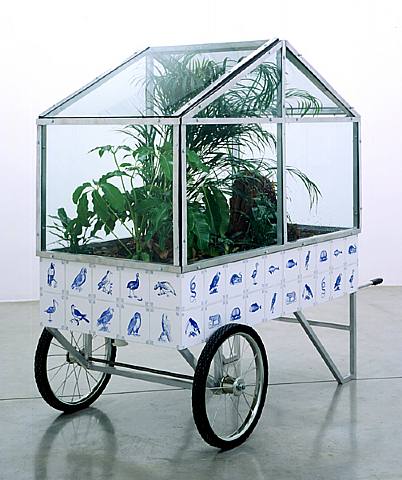
Mobil bio-type jungle. Mark Dion, 2002.
Luego del conocidísimo, citadísimo y traducidísimo texto de “El artista como etnógrafo”, Hal Foster publicó en el número 115 (otoño del 2004) de la revista October otra de sus interesantes clasificaciones: “El impulso archivístico” (”The archival impulse”), donde enmarca un conjunto de procesos de artistas como Thomas Hirschhorn, Mark Dion y Tacita Dean.
Además de las tácticas de serialización, taxonomización y modos de presentación de estos procesos -que apropian estrategias archivísticas de exhibición- está la noción de archivo en el sentido foucaultiano, es decir, el archivo como “sistema que rige la aparición de los enunciados como acontecimientos singulares. Pero el archivo es también lo que hace que todas esas cosas dichas no se amontonen en una multitud amorfa…”
En el caso de la obra de Alberto Baraya, me pregunto si la práctica archivística articula su producción, y si en esta medida dicha práctica implica tácticas de presentación. O si la acogida que han tenido los Herbarios hace extensiva esta práctica a toda la producción del artista. Al ver sus Herbarios de Plantas Artificiales, es precisamente el orden utilizado al disponer la plantas lo que le nos refiere a la idea de archivo, y de allí al rigor con que este artista recolecta y presenta sus hallazgos.
Sin cuestionar en ningún momento los procesos que presentó, como los mencionados “herbarios de plantas artificiales”, las fotos de las iglesias, el video del río, la rama en látex del arbol, etc, creo que la “puesta en espacio” de estos trabajos desaprovechó la riqueza y variedad de posibilidades de presentación que ofrece el concepto mismo de archivo, entendido no sólo desde Foucault y Foster, sino desde la misma forma en que Baraya ha presentado sus propuestas y, por supuesto, del reto que implica la relación con el espacio expositivo en un concurso como el Premio Luís Caballero.
Buscando en este gran archivo que es Internet, encontré el texto de Hal Foster, cuyo enlace va al final este mensaje, y otro que creo podría ser de interés para darle un ‘marco’ al archivo como práctica artística: un fragmento del artículo “The documentary impulse” de la crítica e historiadora francesa Vivian Rehberg, que a su vez le da un ‘marco’ al texto de Foster:
Archives and documentation in the postmodern era
Following on Craig Owens’s groundbreaking text ‘The Allegorical Impulse: Towards a Theory of Postmodernism’, Hal Foster has convincingly pointed to an archival impulse in contemporary art which, though not a new phenomenon, is both specific enough in its practices and wide-spread enough to be considered a ‘tendency in its own right’. The archival impulse (in works by artists like Tacita Dean, Mark Dion, Thomas Hirschhorn and Sam Durant, amongst others) implies the use of such formal tactics as serialization, recuperation of images, texts, and objects, most frequently in installations but also in singular works, in an effort to ‘make historical information often lost or displaced, physically present.’3 According to Foster, archival work is productive; it ‘not only draws on informal archives but produces them as well, and does so in a way that underscores the nature of all archival materials as found yet constructed, factual yet fictive, public yet private. Further, it often arranges these materials according to a quasi-archival logic, and presents them in a quasi-archival architecture, a complex of texts and objects (again, platforms, stations, kiosks…).’ Importantly, Foster concludes that this productivity is perhaps indicative of a shift away from a melancholic relationship to culture and society toward a more sanguine, if not utopian, one.
Foster has laid out a useful typology for identifying the archival impulse, which he links to and differentiates from the postmodern appropriation strategies, critiques of representation, authorship and originality that were tied to engagements with identity politics and a more extensive ‘deconstructive turn’ during the 1980s. Postmodern theories and practices radically called into question natural and culturally determined links between appearance and essence, reality and simulation. Some asserted that we exist in a media-scape of signs whose anchors to the real are highly contestable, or which rarely reflects anything real at all. At present, much of what we know of the world comes to us through images that may or may not be trustworthy. The sheer wealth and diversity of the images that enter into our visual fields on any given day – during the vastly different experiences of reading or looking at print media, television or cinema, walking down the street, down the aisles of a supermarket, or through an exhibition – as well as all of the images we won’t see, that have gone underground, have been fabricated solely for an occasion and are destined to disappear from our sight and our memories, continue to blur the boundaries between the fictions of simulation and the facts of the real.
How can the document and the documentary – historically anchored to the real – negotiate this increasingly distorted terrain? Archives, whose fragmentary natures, elusive contents, and ephemeral structures, as Foster reminds us, are built on a dialectic of interiorization and exteriorization. Documents – which are, of course, crucial elements of archives – purport to reveal, to enunciate their truths straightforwardly, and to serve as evidence.6 Documentaries, which put documents and archives into motion, rely on and are an integral component of archives. Prompted to take stock of our vast and unwieldy visual world, all three of these practices and forms coincide and overlap and serve the varying ends of surveillance and control, memory and counter-memory, truth and speculation.
artículo completo >
http://www.jong-holland.nl/4-2005/rehbergeng.htm
“Archival impulse” / Hal Foster
http://www.mitpressjournals.org/doi/abs/10.1162/0162287042379847
Rodrigo Leyva